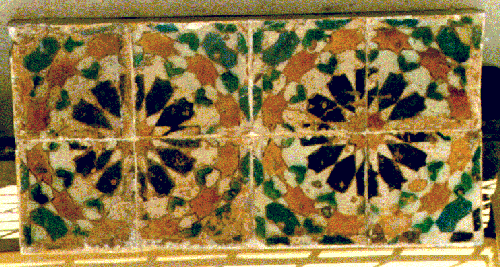|
| Wall Tiles from the Convent of Jesus, Setúbal: 16th century AD |

Portugal and Spain were the transmitters of the Medieval Islamic tradition of decorative wall and floor tiles to modern Europe.
These hispano-moresque tiles, found in excavations in the cloister of the Convent of Jesus, were imported from Seville in Andalusia, the most important centre of tile production in Spain. They were produced using the corda seca technique in which the clay plate still in raw was moulded with the drawings in relief. The tracks created on the plate were then filled with manganese with grease. This would transform, when cooked, in a thin black bar allowing the separation of the colors of the tile, preventing them to be mixed and also preventing the pattern to be smudged.
This technique gave way to the edge technique (aresta) in which the mould was made with re-entrances which would create thin saliences allowing an easier separation of colors.
Both these techniques, as well as the islamic influenced hispanic-moorish geometrical designs were replaced along the 16th century by the majolica technique, introduced by italians in Seville's workshops. With this technique the clay plate needs no more separating lines between the colors because it is covered with white stanniferous enamel (made with lead oxid and tin oxid) allowing the application of colors without mixing between them.
The portuguese tile production was mainly develloped by the second half of the 16th century, partly due to the arrival of flemish tile makers in Portugal.
© 1998 Oxfordshire Museum Service, Setúbal Museums and the Benaki Museum